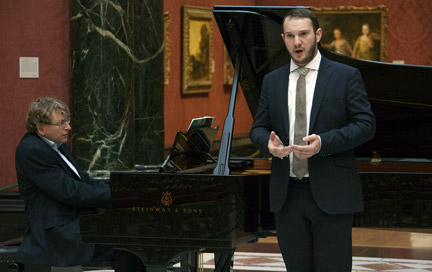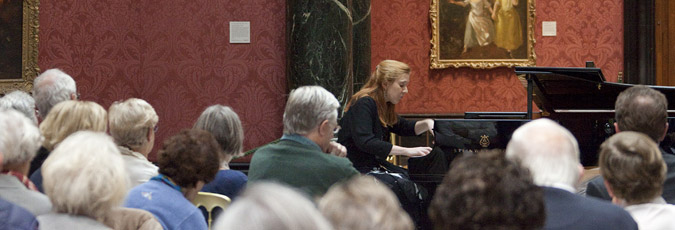The National Gallery stages modern-day concerts to celebrate the very special legacy of Myra Hess’s wartime recitals.
The concerts today
Sarah Beth Briggs, pianist
Transcription
Sarah Beth Briggs: 'She was just an incredible musician, you know, a real force to be reckoned with musically. Particularly in the classics in Mozart and Beethoven, in Schubert, in Haydn - she had so much to say. It is very, very difficult to put into words what make somebody special. So often it's a question of maybe the space they leave between the notes rather than the way that they play the notes. it is something that you have to hear rather than talk about in a sense I think, because the difference between a good pianist and a great pianist is often very, very subtle, but even if you didn't know the music very well - I think it becomes evident when you listen to somebody who is great - and she had that greatness.'
When the wartime concerts finished in 1946, Myra Hess expressed her wish that music would one day return to the National Gallery.
It has done so in recent years and – to the delight of those who remember the original story – it has returned in her name.
Every year, Myra Hess Day brings together a warm-hearted audience to celebrate all that the original concerts embodied and achieved. Friends and relatives of Myra Hess attend, along with members of the wartime audience, and a new generation who have been touched by the story. They come to remember the courage, hope and determination that motivated Myra Hess and her team, and to enjoy performances of a concert-hall standard in the intimate settings of the gallery.
The recitals are held in the Barry Rooms, the galleries where Myra Hess used to stage her events. A grand piano is carefully moved into position, among paintings by Reynolds, Hogarth and Canaletto, and the audience gathers to hear great works of classical repertoire performed.
Hetty Bauer, attendee
Transcription
Hetty Bauer: 'My name is Hetty Bauer and I am 107 - I have just had a birthday!
What was it like to come to the Myra Hess concerts during the war?
'It was a lovely break from what were a lot of mundane jobs that I had to do. Becuase I was the warden of a hostel for refugees from Czechoslovakia. She was a great pianist and I have always loved classical music. World War One began my musical education - the cry of the street runners "All to the bottom of your houses!" "All to the bottom of your houses!" And my mother calling out to us "Bring your pillows with you, bring your pillows down."
You with the rest of the children were hiding under the table.
'Under the mahogony table with the pillows. On top of that table stood the HMV - His Master's Voice - gramophone, that I would say began my love of Mozart and Beethoven particularly.'
The recitals are of the highest standard, and yet – in keeping with the very special legacy which they commemorate – always a family affair. Friends and relatives of Myra Hess attend, along with members of the wartime audience, and a new generation of fans.
A number of Myra Hess’s pupils – now distinguished pianists themselves – have appeared over the years, including Stephen Kovacevich, the Contiguglia brothers ̶ Richard and John, and the late Yonty Solomon, who in turn taught the celebrated international pianist, Piers Lane ̶ Myra Hess’s ‘grandpupil’ and the artistic director of the events.
Sarah Beth Briggs, pianist
Transcription
Sarah Beth Briggs: 'It is always awe-inspiring to play surrounded by such beauty. You do feel as though you are going back in history, being there in the space, playing where she played on exactly the same spot - and what a spot to be on. And now of course surrounded by all those wonderful pictures, which weren't there when she was playing during the war. The audience were very warm and the feedback felt very good and it felt a very nice place to be. Of course for me, my late teacher Denis Matthews who was a great friend of hers, was also playing in that space on a very regular basis, so it was very special for me today. Denis was just a tremendous admirer of her talent and no doubt lots of things rubbed off as subsequently they did from him to me - so that feels a rather nice link with the late Dame Myra.'
The modern-day concerts began in 2006, when the Gallery and Jewish Culture UK decided to mark three and a half centuries of British Jewish Life by staging a special tribute to Myra Hess. During the period from 2006 to 2012, the annual Dame Myra Hess Day was generously supported by The Ernest Hecht Charitable Foundation.
Ernest Hecht, sponsor 2007-2012
Transcription
Ernest Hecht: 'I remember Myra Hess concerts from the war - I was a kid'
Did you ever go to any of the concerts?
'No, because I could never get in! I was walking around and there were these huge queues, they used to circle Trafalgar Square, and I actually think that she did more for morale than almost anyone else. And to do it every day during the war - I would actually place her with Vera Lynn.'
And, so as an adult, what was it that made you come back to Myra Hess?
'Well, because I think she didn't get the right sort of recognition for this extraodinary thing that she did throughout the war, after all she was a major, major artist and to do so much for morale, I thought it was time that it was recognised.'


